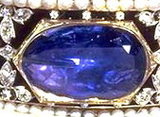
Famous Sapphire Jewellery, Part 8: Circlet of the Imperial State Crown, Home of the Stuart Sapphire
Share
The circlet of the Imperial State Crown of Britain holds the Stuart Sapphire. Bearing the name of the Stuart Dynasty, the Stuart Sapphire is a large deep blue gem that weighs approximately 104 carats. The Stuart Sapphire made its first documented appearance in 1214, when it was set into the crown of Alexander II, King of Scotland for his coronation. His son Alexander III inherited the sapphire after his father’s death in 1249. When Alexander III died in 1286, he had no direct living heirs, and this caused a disturbance in the succession of Scotish kings. His granddaughter Margaret, who at the time was an infant, was chosen to take the throne. King Edward I of England arranged a marriage between his son Edward II and Queen Margaret in 1290, but she died before reaching England. King Edward I attempted to take control of Scotland now that the nation lacked a ruler, but he faced resistance from the Scots.

John Balliol was declared King of Scotland in 1292, after which King Edward invaded. During the invasion, Edward captured the Stuart Sapphire and the Stone of Scone, a large yellow sandstone that was associated with the coronation of Scottish kings. Edward II inherited the Stuart Sapphire after his father’s death in 1307, and after he was deposed in 1327 his son Edward III took possession of the gem. Edward III’s sister Joanna married David II, son of Robert I, King of Scotland in 1328 under the Treaty of Northampton. David II became king of Scotland in 1329, and he was invaded by Edward III in 1333, after which David was exiled to France. Following his return from exile in 1357, the Stuart Sapphire and the Stone of Scone were given back to David by Edward III. David II eventually gave the Stuart Sapphire to Marjorie Bruce, daughter of King Robert I. After the death of Robert I, Marjorie’s son Robert II became king and she passed the sapphire on to him. Robert II passed the Stuart Sapphire on to his son Robert III, and it was then owned successively by James I, James II, and James III. The Stuart sapphire was passed on to King Edward IV sometime during the reign of James III, and Edward had the stone set into the crown which had once belonged to Edward the Confessor.

Edward’s crown was destroyed at the end of the Second English Civil War, but the Stuart Sapphire was apparently sold to someone and survived the incident. The stone was returned to the monarchy when Charles II was crowned in 1660. Charles II passed the sapphire down to James II, who was then deposed in 1688 during the Glorious Revolution. James II escaped to France and took the Stuart Sapphire with him; after his death, the Stuart sapphire was inherited by his son James Edward, who then passed the stone down to his son, Charles. After the death of Charles Edward, the Stuart Sapphire fell into the possession of Charles’ brother the Cardinal of York, Henry Stuart, the last surviving member of the House of Stuarts and the namesake of the Stuart Sapphire. Stuart then relinquished ownership of the sapphire to the royal family sometime during the reign of King George III. In 1838, the Stuart Sapphire was set into the front of the Imperial State Crown, which had been crafted at the request of Queen Victoria for her coronation ceremony.

In 1907, King Edward VII was given the Cullinan diamond for his 66th birthday, which had been discovered in South Africa two years prior, and in 1909 the King had the second largest gem cut from the stone, the Cullinan II diamond, set into the Imperial State Crown in place of the Stuart Sapphire, which was then moved to the back of the crown. In 1937, the second version of the Imperial State Crown was crafted for the coronation of King George VI, and all of the stones set into the original crown were transferred to the corresponding location on the new crown, where they have remained ever since. Today, the Imperial State Crown maintains its role in coronations and parliamentary affairs, but also spends much of its time on display in the Tower of London as part of the British Crown Jewels.

Without any question, the Imperial State Crown of Britain and the sapphires it holds are some of the most historically significant sapphire treasures that are known today. These jewels are quintessential examples of the importance that humans have ascribed to sapphires, and like all sapphire jewellery, exemplify the universal appeal of the gemstone known as sapphire.
We'd love to help you turn any of these gorgeous sapphires into a piece of custom jewellery:
© Yaĝé Enigmus









